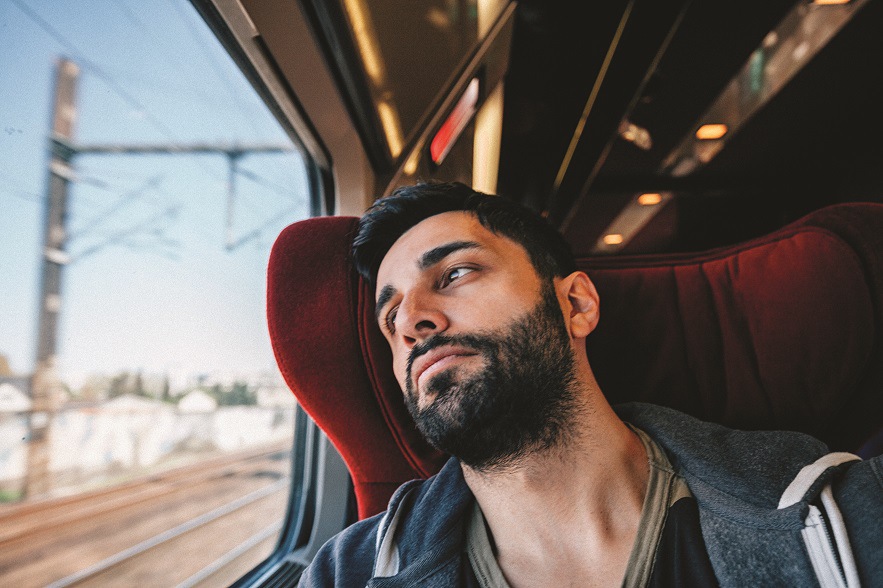Donna DeFalco, President of the Health Enhancement Company, gives 10 mindful ergonomics tips for travelling.
Hustling from a long workday to catch the next train or flight to an early morning meeting, firing on all cylinders…sound familiar to you? Nothing about this type of travel seems remotely mindful or ergonomic- in fact, simply landing in your seat on time with a snack to sustain you might feel like the only relaxing moment of the whole trip.
There is a place, however, where ergonomics, mindfulness, and travel can meet, and when put into practice, it can be an absolute game-changer.
Mindful ergonomics is a concept that I have been teaching and introducing to corporations for over 35 years. Simply put, it is the act of focusing on how your body is performing tasks, giving your brain a break from all the stories and chatter. Let’s revisit our scenario from the beginning:
As you make your way from the office, are you bent over, sending a text from your phone, fingers gripping and autocorrecting, shoulders hunched up to hold your bag in place as you race to get in line for the next destination? Are you aware of your body and your breathing patterns only when you reach the threshold where discomfort meets pain?
How does this influence your reactions when the inevitable variables of travel come into play: long lines, delays, cancellations, the crying baby or the snoring seatmate?
I think most of us believe that’s just part of the travel experience, and we accept this stressful state as the norm when in most cases it is actually preventable – and not just when travelling. If you take a moment to breathe and focus on what is going on – internally and externally – the practical application of mindfulness can significantly reduce the stress, discomfort, and awkward postures and habits that are related to ergonomics. This allows you to become proactive in your responses, enjoying or accepting the present moment wherever your travels may take you. Yes, this line is long. But if I take a moment to adjust my posture, put my phone away, take the bag off my shoulder, breathe, look around without judgment, simply accepting what is there? It instantly has a tremendous effect on me and what I am experiencing. I’ll be waiting either way; the better course of action is clear.
Next time you’re about to hit the road, give these exercises a try. You have nothing to lose and much to gain- who doesn’t want to travel comfortably, feel focused, refreshed, and ready to work with no discomfort? (As an added bonus, you’ll probably find you have the energy for a little “me time” upon arrival!)
1. Unplug
Take 5 deep breaths as you close your computer and head out of the office to your destination. Give your brain a rest and note how you feel, where you feel it, and reposition yourself before you throw on that heavy bag. Repeat when you arrive at your destination.
2. Present Moment
As you are walking to your destination, notice each foot as it touches the ground, notice your knees lift, feel the air around you. No matter where you are, there is always a rich experience to be had (yes, even at the bus terminal in your least favourite city). Enjoy the sensations of being in the present moment.
3. Brain Chatter Challenge
Allow your mind to wander, then inhale, close your eyes and bring yourself into the present moment. Focus on your breathing, a deep and even inhale and exhale. Repeat this cycle: wandering, then focusing on your breath, at least 5 times.
4. Savour
Before you eat a meal, a snack, or have a drink at a cocktail party, take a deep breath. Look at what you are about to consume and notice its colour, notice the portion as you take your first bite or sip (make it a small one). Observe the texture, the flavours, and as you swallow, enjoy the sensation of sustenance.
5. Truly Relax
Carve out a time with no schedule, no devices, no drinks with colleagues, just “me time”-you only need a moment. Melt into the present, look at a dark sky, watch the sunrise or set, really see a piece of art, whatever it is, absorb it. Place the image in your mind, reflect on the feelings it brings to you. Call the image back to relax and recharge whenever you need it in the future.
6. Observe You
Mindful posture is beginning your day in neutral. Take a moment to engage the back of your chair, see if feels comfortable on your back, if your feet touch the floor, if the armrests allow your shoulders to drop, if your head and chin are in line with your spine. As you begin your workday, notice if you are moving from this optimal posture to work with your tools. If you are, stop and adjust your tools to work for you. Pay close attention throughout your day.
7. Break Away
On your break, instead of falling into a social media feed, close your eyes for a minute and change focus. Take 3 deep breaths, step away from your work area and move your body a little, a brief walk or a nice stretch. If you have the time, finish up with the Brain Chatter Challenge.
8. Get your ZZZ’s
Sleep is so very important. To prepare for a restful night, create a bedtime tea ritual in your hotel room: Steep an infusion of lavender, lemon balm, valerian root and chamomile. (If you can’t get loose tea, a bag of Sleepytime tea works as well). Place the warm cup in your hand. Take in the soothing sensation, breathe in the aroma and the steam, close your eyes and sip. Stay in the present moment and enjoy a good night’s sleep in your home away from home.
9. Resilience
Mindful ergonomics while travelling is a practice. We all have a bad day, or listen to our brain chatter about not having time, not even a minute. Not to worry: your tools are always there for you when you want to start again. For a quick reset on the go, simply STOP:
Stop
Take a deep breath
Observe
Proceed or change perspective
10. Apply the ABC’s of Mindfulness
- Awareness: Become more aware of what you are thinking and doing – what’s going in your mind and your body.
- Being: Avoid the tendency to respond on auto-pilot and feed problems by creating your own story.
- Clearly Seeing: By creating a gap between the experience and our reaction to it, we can make wise choices and become more creative.
Remember, this isn’t about “right” or “wrong”, but finding ways on our journey to bring healthy balance into our lives, vitality to our bodies and richness into every experience. I wish you the very best of travels.
This article appears in the latest issue of Cardinus Connect. Download it for free, here.



